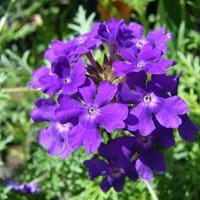Life Span
Perennial
Annual
Type
Broadleaf Evergreen
Flowering Plants
Origin
China, Japan
America, Europe
Types
Heavenly Bamboo, Nandina 'Colerno'
Dwarf Nandina 'Compacta'
Dwarf Nandina 'Filamentosa'
Heavenly Bamboo, Nandina 'Harbor Belle'
Heavenly Bamboo, Nandina 'Moon Bay'
Clump verbena, Moss verbena, Annual Verbena, Brazilian verbena, Sandpaper Verbana
Habitat
low mountains, Mountain tops, Mountains, Valley
Forest edges, Hillside, Woods
USDA Hardiness Zone
6-11
3-9
AHS Heat Zone
Not Available
Not Available
Sunset Zone
21,22
not available
Habit
Clump-Forming
Not Available
Flower Color
Not Available
Blue, Dark Purple, Light Purple, Red, White
Flower Color Modifier
Bicolor
Not Available
Fruit Color
Not Available
Not Available
Leaf Color in Spring
Green, Purple, Copper
Dark Green
Leaf Color in Summer
Green, Purple
Dark Green, Green
Leaf Color in Fall
Green, Purple
Dark Green, Green
Leaf Color in Winter
Red, Green, Purple
Not Available
Leaf Shape
Acuminate
Oblovate
Plant Season
Spring, Summer, Fall, Winter
Early Spring, Late Autumn
Sunlight
Full Sun, Partial Sun, Partial shade, Full Shade
Full Sun, Partial shade
Type of Soil
Loam, Sand
Well drained
The pH of Soil
Acidic, Neutral, Alkaline
Neutral, Slightly Acidic
Soil Drainage
Well drained
Average
Bloom Time
Not Available
Early Fall, Early Summer, Fall, Late Spring, Late Summer, Summer
Tolerances
Drought
Not Available
Where to Plant?
Ground
Container, Ground
How to Plant?
Seedlings
Seedlings, Stem Planting
Plant Maintenance
Medium
Medium
Watering Requirements
Do not water frequently, Needs less watering
Do not water frequently, Medium, Never Over-water, Requires regular watering, Requires watering in the growing season
In Summer
Lots of watering
Lots of watering
In Spring
Moderate
Moderate
In Winter
Average Water
Average Water
Soil pH
Acidic, Neutral, Alkaline
Neutral, Slightly Acidic
Soil Type
Loam, Sand
Well drained
Soil Drainage Capacity
Well drained
Average
Sun Exposure
Full Sun, Partial Sun, Partial shade, Full Shade
Full Sun, Partial shade
Pruning
Remove damaged leaves, Remove dead branches, Remove dead leaves
Prune for shortening long shoots, Prune if you want to improve plant shape, Prune lower leaves, Prune regularly, Prune to control growth
Fertilizers
All-Purpose Liquid Fertilizer
All-Purpose Liquid Fertilizer
Pests and Diseases
Red blotch
Not Available
Plant Tolerance
Drought
Drought
Flowers
Not Available
Yes
Flower Petal Number
Not Available
Single
Showy Foliage
Yes
Not Available
Foliage Texture
Fine
Not Available
Foliage Sheen
Glossy
Not Available
Invasive
No
Not Available
Attracts
Mealybugs, Whiteflies
Butterflies
Allergy
Not Available
Arthritis, Asthma, Chest Pain, Itchiness, Whooping Cough
Aesthetic Uses
Bonsai, Borders
Showy Purposes
Beauty Benefits
Not Available
Not Available
Environmental Uses
Air purification
Air purification
Medicinal Uses
Antirheumatic, Antitussive, Astringent
Arthritis, Gallbladder Diseases, Itching, Jaundice, Joint pain, Kidney problems, Liver problems, Metabolic disorders, Sore throat, Upset stomach, Urinary tract problems
Part of Plant Used
Fruits, Leaves
Flowers, Root
Other Uses
Used for making informal hedge
Air freshner, Can be made into a herbal tea, Cosmetics, Decoration Purposes, Economic Purpose, Employed in herbal medicine, Oil is used for aromatherapy, Oil is used in perfume, soaps, creams, etc., Showy Purposes, Used As Food, Used as Ornamental plant, Used for flavoring in Liquors, dairy products, gelatins,puddings, meats, candies, etc., Used for fragrance
Used As Indoor Plant
No
No
Used As Outdoor Plant
Yes
Yes
Garden Design
Container, Edging, Foundation, Groundcover, Hedges, Mixed Border, Topiary, Bonsai, Espalier
Bedding Plant, Bonsai, Container, Edible, Herb
Botanical Name
NANDINA domestica 'Nana Purpurea'
Purpletop Vervain
Common Name
heavenly bamboo
sacred bamboo
nandina
Verbena
In Hindi
Dwarf Nandina
verbena
In German
Dwarf Nandina
Eisenkraut
In French
Nandina Dwarf
verveine
In Spanish
Nandina enana
Verbena
In Greek
Dwarf Nandina
λουίζα
In Portuguese
Nandina do anão
verbena
In Polish
Dwarf Nandina
werbena
In Latin
Dwarf Nandina
Grindelia
Phylum
Tracheophyta
Magnoliophyta
Class
Magnoliopsida
Magnoliopsida
Order
Ranunculales
Lamiales
Family
Berberidaceae
Verbenaceae
Clade
Angiosperms, Eudicots
Not Available
Tribe
Not Available
Not Available
Subfamily
Not Available
Not Available
Number of Species
Not Available
Importance of Dwarf Nandina and Verbena
Want to have the most appropriate plant for your garden? You might want to know the importance of Dwarf Nandina and Verbena. Basically, these two plants vary in many aspects. Compare Dwarf Nandina and Verbena as they differ in many characteristics such as their life, care, benefits, facts, etc. Every gardener must at least have the slightest clue about the plants he wants to plant in his garden. Compare their benefits, which differ in many ways like facts and uses. The medicinal use of Dwarf Nandina is Antirheumatic, Antitussive and Astringent whereas of Verbena is Arthritis, Gallbladder Diseases, Itching, Jaundice, Joint pain, Kidney problems, Liver problems, Metabolic disorders, Sore throat, Upset stomach and Urinary tract problems. Dwarf Nandina has beauty benefits as follows: Not Available while Verbena has beauty benefits as follows: Not Available.
Compare Facts of Dwarf Nandina vs Verbena
How to choose the best garden plant for your garden depending upon its facts? Here garden plant comparison will help you to solve this query. Compare the facts of Dwarf Nandina vs Verbena and know which one to choose. As garden plants have benefits and other uses, allergy is also a major drawback of plants for some people. Allergic reactions of Dwarf Nandina are Not Available whereas of Verbena have Arthritis, Asthma, Chest Pain, Itchiness and Whooping Cough respectively. Having a fruit bearing plant in your garden can be a plus point of your garden. Dwarf Nandina has no showy fruits and Verbena has no showy fruits. Also Dwarf Nandina is not flowering and Verbena is flowering. You can compare Dwarf Nandina and Verbena facts and facts of other plants too.





